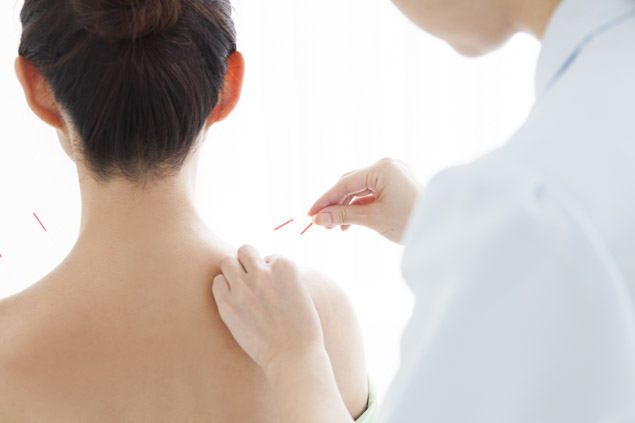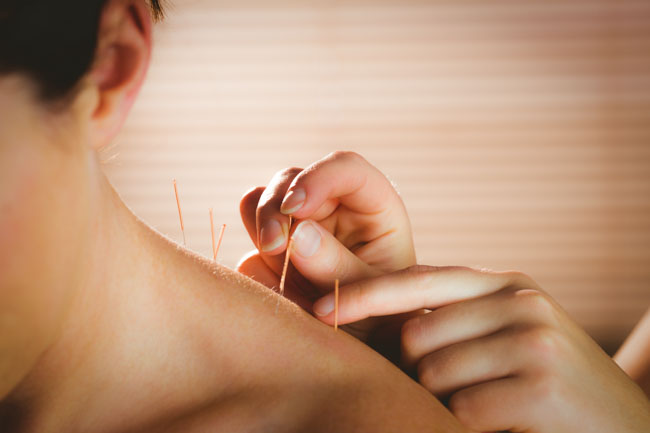Researchers demonstrate that acupuncture eliminates or reduces neck pain for patients with cervical spondylosis, a painful disorder caused by intervertebral disc degeneration.
Acupuncture alleviates pain due to cervical spondylosis. In a sham-controlled study, researchers demonstrate that acupuncture has a total effective rate of 75.5% and provides significant positive patient outcomes for patients with cervical spondylosis. Additional research finds acupuncture combined with moxibustion and massage effective for the relief of neck pain.

Acupuncture relieves pain caused by cervical spondylosis. Liang et al. explored the main factors influencing the therapeutic effects of acupuncture on neck pain caused by cervical spondylosis. In a controlled study, 160 patients were randomly divided into a standard acupuncture group and a sham-acupuncture control group, with 53 patients in each group. The standard acupuncture group was treated with acupoints at
- Dazhui (GV14)
- Jingbailao (Ex-HN15)
- Jianzhongshu (SI15)
The control group was treated with sham-acupuncture with the sham points located 1 cm lateral to
- Bailao (Ex-HN15)
- Jianzhongshu (SI15)
The needles were retained for 20 minutes per session in each group and infrared radiation was used for adjuvant treatment during this period. The Northwick Park Neck Pain Questionnaire (NPQ) was used to assess quality of life scores before and after the treatments. Variables were analyzed by logistic regression. The total effective rate was 75.5% in the standard acupuncture group and 52.8% in the sham-acupuncture control group. The logistic regression analysis indicates that the therapeutic effects and positive patient outcomes in the standard acupuncture group are superior to that of the control group receiving sham-acupuncture.

In addition to conventional acupuncture, researchers also investigated acupuncture combined with moxibustion and massage. In a study to evaluate the clinical efficacy of acupuncture and moxibustion on chronic neck pain due to cervical spondylosis, 111 cases were randomized into two acupuncture groups (Xu et al.). In acupuncture group one, acupuncture was applied to
- Bailao (EX-HN15)
- Shenmen (HT7)
- Wangu (SI4)
Next, direct moxibustion was applied to
- Dazhui (GV14)
- Xinshu (BL15)
- Shenshu (BL23)
Upon completion of moxibustion, intradermal needling therapy was applied to
- Bailao (EX-HN15)
- Xinshu (BL15)
- Shenshu (BL23)
In acupuncture group two, acupuncture was initially applied to
- Bailao (EX-HN15)
- Zhongzhu (TB3)
Next, direct moxibustion was applied to
- Dazhui (GV14)
- Bailao (EX-HN15)
- Jianzhongshu (SI15)
After moxibustion, intradermal needling therapy was applied to
- Bailao (EX-HN15)
- Jianzhongshu (SI15)
The Northwick Park Pain Questionnaire (NPQ) was adopted as the main efficacy index for the evaluation. After the intervention and during the follow-up visit period, NPQ scores were all reduced remarkably as compared with those before the intervention for patients in both groups. This indicates significant clinical improvement using two different approaches to acupoint prescription selections.
In another multi-centered controlled study, eligible subjects were randomly divided into an acupuncture-massage group, an acupuncture group, and a massage group, with 60 cases in each group (Zhou et al., Lin et al.). There were no differences in baselines among the three groups at the onset of the investigation. The total effective rate was 88.3% in the acupuncture-massage group, 75.0% in the acupuncture group, and 76.7% in the massage group. The acupuncture-massage group demonstrated greater positive patient outcomes over the other two groups. After treatment, the total cumulative scores for symptoms in the three groups decreased significantly. The physical signs in the three groups improved significantly with no significant differences among the three groups. The initial time to show clinical improvements in the acupuncture-massage group was more rapid than that of the other two groups. Based on the findings, acupuncture is an effective treatment for cervical spondylosis, especially when combined with massage or moxibustion. Given the scientific evidence, additional clinical research is warranted.
References:
Liang ZH, Yang YH, Yu P, Zhu XP, Wu ZL, et al. (2009) [Logistic regression analysis on therapeutic effect of acupuncture on neck pain caused by cervical spondylosis and factors influencing therapeutic effect]. Zhongguo Zhen Jiu 29: 173-176.
Xu SJ, Liang ZH, Fu WB (2012) [Chronic neck pain of cervical spondylosis treated with acupuncture and moxibustion in terms of the heart and kidney theory: a randomized controlled trial]. Zhongguo Zhen Jiu 32: 769-775.
ZHOU Jianwei HL, LI Ning, ZHANG Fan,LI Chunyu, ZHAO Jingjing, LI Ji,HU Yunguan,ZHANG Yan,WANG Chengwei (2005) Multicenter randomized-controlled study on acupuncture-massage comprehensive program for treatment of cervical spondyiosis of arterial type. Zhongguo Zhen Jiu 25: 227-235.
Lin Hanlng SH, Zhong Weihong, Chen Shaoqing,Wang Shizhong (2009) Effects of different acupuncture and moxibustion treatments on cervical spondylotic radiculopathy:A systematic eVaIuation. Joumal of clInical Rehabilitative Tlssue Engineenng Reseanch 13: 9017.


